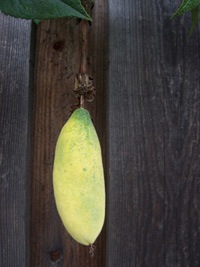Ethiopia’s Institute of Biodiversity Conservation reminded us today — quoting an IUCN study from last year — that the African Wild Ass (Equus africanus) is critically endangered. Actually the Asiatic Wild Ass is also in trouble. The summary of the findings of the 2008 IUCN Red List of threatened mammals highlights the situation in SE Asia as particularly worrisome. People are clearly going through the data now and pulling out different themes. A few days ago there was an assessment of the state of rabbits, for example. I wonder if we can look forward to an overview of livestock wild relatives?
Farm business doing OK
Department of Silver Linings: No matter how bad things get, people still need to eat. The Economist reports on good times in the agriculture industry, even though “much of the global economy is falling apart and demand both for consumer goods 1 and the firms that make and finance them is collapsing”. You want scary?
China is consuming twice as much vegetable oil (instead of less healthy pork fat), 60% more poultry, 30% more beef and 25% more wheat, and these are merely the obvious foods. Scores of niches have expanded dramatically: people are drinking four times as much wine, for example.
And yet even with all this growth, people in China still, on average, consume only one-third as much milk and meat as people in wealthy countries such as Australia, America and Britain. The gap is even larger with India, which is also growing fast.
Buy now, while stocks last.
Do you know this fruit?
 The folks over at The Human Flower Project are trying to identify this fruit, which apparently can be found in abundance in Oakland, California. They think they’ve pinned it down to Passiflora mollissima, but maybe you know better. I grew P. mollissima once, in an unheated greenhouse, and although it flowered well enough it didn’t set fruit. So although the flowers look familiar, the fruit remains a mystery. One of the reasons I wanted to grow it was to do this:
The folks over at The Human Flower Project are trying to identify this fruit, which apparently can be found in abundance in Oakland, California. They think they’ve pinned it down to Passiflora mollissima, but maybe you know better. I grew P. mollissima once, in an unheated greenhouse, and although it flowered well enough it didn’t set fruit. So although the flowers look familiar, the fruit remains a mystery. One of the reasons I wanted to grow it was to do this:
“The pulp is eaten out-of-hand or is strained for its juice, which is not consumed alone but employed in refreshing mixed cold beverages. In Bolivia, the juice, combined with aguardiente and sugar, is served as a pre-dinner cocktail. Colombians strain out the seeds and serve the pulp with milk and sugar, or use it in gelatin desserts. In Ecuador, the pulp is made into ice cream.â€
Those treats remain a fond hope. I had a quick look to see whether the juice or pulp might be available commercially in Europe, but couldn’t find anything. Is it?
Distributed herbarium documentation
Distributed computer projects are taking off in a big way. “Many are run on a volunteer basis, and involve users donating their unused computational power to work on interesting computational problems.” That usually means looking for extraterrestrial life or working out the structure of black holes or proteins while your computer idles away. Herbaria@home is a bit different. When you sign up as a volunteer, you receive scans of herbarium sheets, you digitize the label information, and these data are then added to the herbarium’s information system. Actually, there are other examples of such projects, which use the public’s spare brain-power, as well as their spare computer-power. I wonder if this approach could be used to improve genebank documentation. Perhaps to geo-reference tricky accessions? Or how about to characterize the morphology of different varieties from photos?